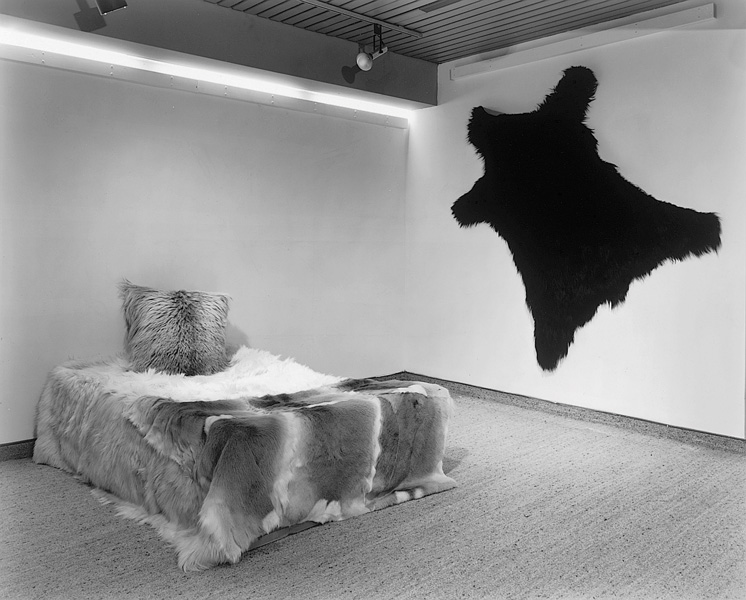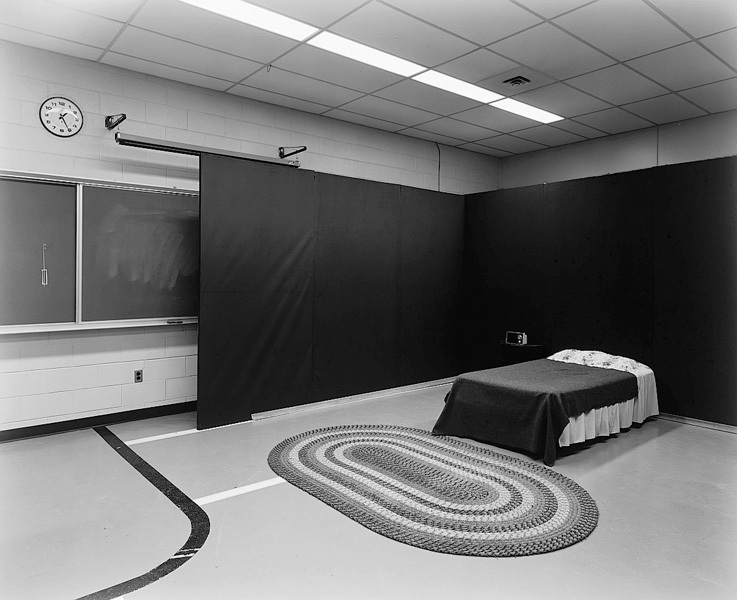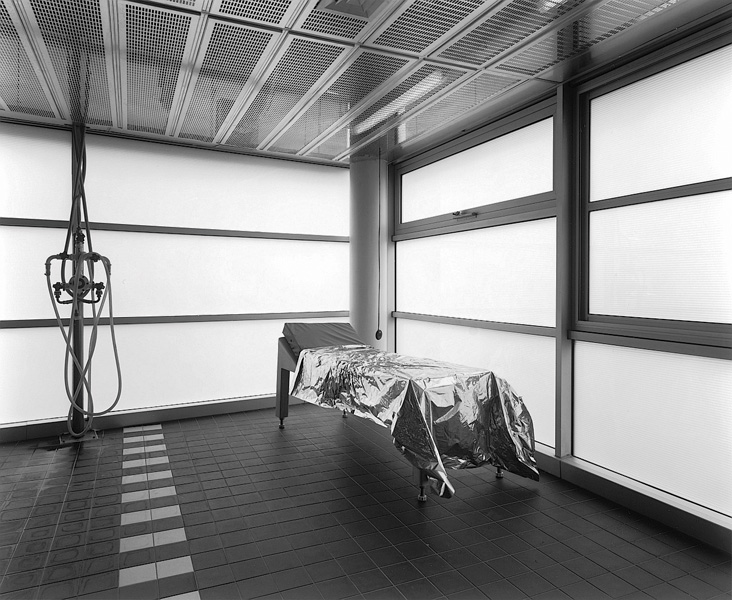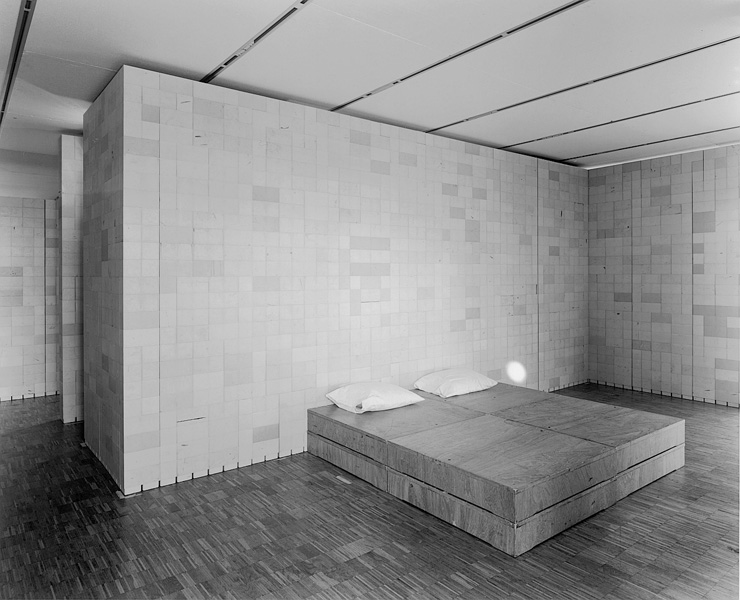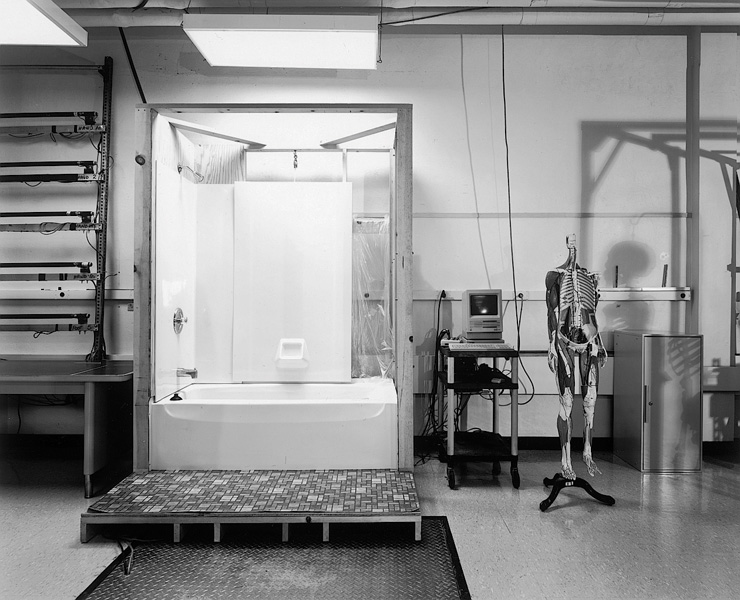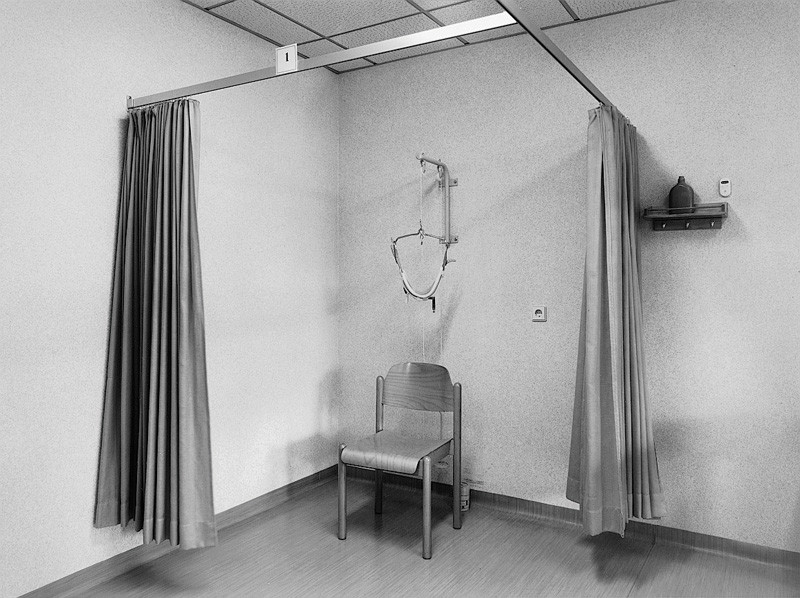[Spring 2006]
by Jean-François Bélisle
Since the early 1970s, Cohen has lived and worked in no fewer than nine countries, photographing unpopulated interiors in public and private establishments such as schools, spas, and laboratories. Her practice has been informed by her nomadic lifestyle. Her mostly black-and-white images may seem to be documentations of specific awkward and cold, yet alluring, spaces. But are they? Cohen’s already complex imagery of the social fabric of contemporary cities is further complicated by her decision not to provide her viewers with information about where they were shot. Viewers are therefore faced with a panoply of found interiors that are as many testimonials to cultural and social environments situated throughout the Western world; none of them, however, can be attached to a specific culture.
The environments depicted in Cohen’s photographs warrant a questioning of the spaces that we inhabit. This interrogation shifts the discourse from one of tension between Self and Other to one of internal instability, which encourages a non-oppositional conception of cultural entities. In order to fully understand how her experiences have paved the way for this new conception, we need to briefly review Cohen’s biography. She is an American-born artist who immigrated to Canada in 1973 and worked mainly in North America until 1988. She then proceeded to actively extend her home ground – or artistic muse, if you will – to a good portion of the Western world. In 1988, Syracuse University invited her to be its artist in residence. During the following fifteen years, through various artist residencies, she lived in France, Belgium, San Sebastian, Canada, the United States, Spain, the Netherlands, and Switzerland. She now resides in Montreal.
The entirety of Cohen’s oeuvre consists of interior spaces, both private and public. They are shot with an 8 x 10 inch camera, which enables her to produce incredibly detailed and sharp images. The large format of her works and the unobstructed foreground seem to allow the viewers to step into the picture if they so desired. This is real space.
But what is this real space? What would the viewer be walking into? Some weird stage set for a new experimental theatre piece? The room depicted in Showroom is very bare and uninviting. The volumes and space make for an interesting composition, but we are more intrigued by the presence only of a bed and a stretched fur hung on the wall. In an attempt to understand this space, we turn to the title. But Cohen’s titles take us only so far. Showroom? OK. A bit of a strange showroom: cold and uninviting, but it does “show” furs.
What should we make of the space depicted in Classroom? Well, yes, it is a classroom, but not like any I have ever seen. What are a bed, a radio, and a woven carpet doing in a classroom? It must have been transformed into a temporary bedroom. But Cohen’s title does not specify that, so we are left to guess.
Here it is crucial to note that Cohen’s photographs are not staged in any way. She photographs these interior spaces as she finds them. This place really exists (or existed) as seen in the photograph. But where does she find these places? A collector once asked her that question and her answer was, “Have you looked at your own lobby recently?”1 Indeed, awkward interiors do exist around us. In fact, I am certain that if you were to walk around your living or work environment for long enough, you would see at least one or two of these “Cohenesque” spaces. But we don’t notice the awkwardness of the interior spaces that we inhabit. We need to see them in print, framed and hung on a wall or reproduced in a book, to think about them. Through her lens, Cohen forces us to focus on them. She pushes our critical thinking about them even further by using her titles to create loose categories that are often unrecognizable in the images themselves.
In a 1998 article called “Nationalism, Identity, and the World-in-Motion: On the Logics of Seriality,” cultural theorist Benedict Anderson speaks at length about the way that series operate in the construction, and maintenance, of cultural identities. He notes a clear difference between two types of seriality: bound and unbound. In his words, bound seriality “has its origins in governmentality, especially in such institutions as the census and elections. [It] is exemplified by finite series like Asian Americans, Beurs, and Tutsis.” Unbound seriality “has its origins in the print market, especially in newspapers, and in the representation of popular performance. [It] is exemplified by open-to-the-world plurals and makes the United Nations a normal, wholly unparadoxical institution.”2 Anderson denotes that both types of seriality are tied to the “modern imagining of collectivity.” However, he believes that only unbound seriality is open-ended and progressive in its constitution of transnational collective cultural identities.
Cohen’s work operates along the lines of such a transnational cultural collectivity. It does this by showing interior spaces that are hinged into categories (spas, laboratories, etc.) yet elusive in their display and unrestrained in their geographical multiplicity. The unbound seriality starts with her titles. By labelling the type of space she photographs, her titles destabilize viewers. She creates series, and categorizes them, yet these categories accomplish the opposite of what categories are meant to do; they do not simplify or organize. She thus forces viewers to re-evaluate their criteria for spatial definitions by bringing to the foreground our ideas about what specific spaces should look like.
Interiors such as the Spa photographs are almost impossible to recognize without the help of the title. The spaces are cold and empty; the weird, frightening apparatuses seem more conducive to torture than relaxation. In one photograph are drawn curtains that are usually found in hospitals and other, similarly unwelcoming institutions. Nothing points to the comfort and relaxation usually associated with a spa. In images such as these, the picture plane destabilizes the title, and vice versa.
This destabilization process is, I believe, at the very heart of Cohen’s artistic project. She has said that the reason behind her choice of location is “as much about her own biography as about the culture – they meet somewhere in between.”3 Throughout her multiple relocations around Europe and North America, she undoubtedly found herself in the destabilizing position of being surrounded by cultural environments that contradicted what she had come to expect. It is as though the various countries she has lived in have merged into a single vision of the world – a vision that is at times composed of juxtaposed, superimposed, and even contradictory parts. Showrooms, classrooms, and spas become muddled.
Cohen’s decision to leave the shots unlocated geographically further encourages destabilization within her viewers. Given their familiar visual vocabulary, one might expect her images to have been shot in the United States, or at least in North America. Yet, dozens of photographs, such as Laboratory, were shot in the late 1990s, when she spent the vast majority of her time in Europe. This image was shot in 1999, when she was living in Holland. What, then, are the consequences of looking at a cultural production, such as a decorated interior, that is halfway across the world, and thinking that it was shot within the confines of the known “home” culture? In images such as this one, her biographical information completely alters the incorporation of the work into a discourse on cultural identity.
The spaces that she highlights through her lens all share an architectural and design vocabulary that makes sense – even if in an awkward manner – to viewers throughout the Western world. They depict spaces that Western viewers are familiar with. As Benedict Anderson wrote, “Natural universality has been profoundly reinforced – everywhere – by an unself-conscious standardization of vocabulary that radically overrides any formal division between local and foreign. . . .”4 In Cohen’s work, the local and the foreign become undistinguishable from one another. This aspect of her work forces viewers to acknowledge cultural similarities and bridges where there previously stood gaps and oppositional differences.
Through her various series of “themed” yet geographically unbound photographs, Cohen is modifying the groupings and definitions that Western viewers have become familiar with. A fur showroom in North America should not look like a laboratory in Holland. But in Cohen’s work, the viewer is not sure which image is the laboratory, or which was shot in Holland.
The medium of photography, though relatively recent art historically, is rich in political history. First envisioned and utilized as a documentary tool, it has never shaken off its documentary connotations. Building on this history, Cohen employs the medium to create artworks that ride the fine line between “objective” documentary artefacts and “subjective” expressive pieces. By working mainly in black and white and producing images with a high level of clarity and accuracy that often feel like scientific studies, she is encouraging viewers to see her photographs as visual definitions of the spaces named in her titles. However, the links that she draws between these terms and their definitions are highly unstable. They never quite line up, and they often even contradict one another. In this constellation of misaligned categories, new groupings emerge.
Cohen’s photographs are constituted of numerous superimposed and interconnected networks; individual interiors call one another back to mind. The technological equipment in Laboratory calls out to the other unintelligible technological devices in her work; the individual beds in the previous works call out to one another. These form networks that stretch across her unbound series, drawing links and unifying her work. The entirety of her oeuvre is a galaxy of disjointed cultural spaces; a list of the various titles she has given to her works since 1973 would read like an odd dictionary that repeats itself without providing a single definition.
These intercultural bridges that Cohen hints at not only are present in her unlocated titles, but also are embodied in the dislocated link between titles and images. The space in-between created by the internal dislocation of signs is thereby populated by the artist herself, and, by extension, by viewers. Her works exist in the liminal space of the interstice between cultural identities. Linking them is the self, be it the artist or you, the viewer.
1 Frédéric Paul, Lynne Cohen: l’Endroit de décor/Lost and Found (Limoges: Fonds régional d’art contemporain Limousin, 1992), p. 37.
2 Benedict Anderson, “Nationalism, Identity, and the World-in-Motion: On the Logics of Seriality,” in Pheng Cheah and Bruce Robbins (eds.), Cosmopolitics: Thinking and Feeling Beyond the Nation (Minneapolis: University of Minneapolis Press, 1998), p. 117.
3 “Lynne Cohen,” in Women Artists in Canada – Celebrating Women’s Achievements (Library and Archives Canada, 2004), http://www.collectionscanada.ca/women/h12-507-e.html
4 Anderson, “Nationalism,” p. 120.
Jean-François Bélisle is an independent art critic currently completing a master’s degree in art history at Concordia University, Montreal.

